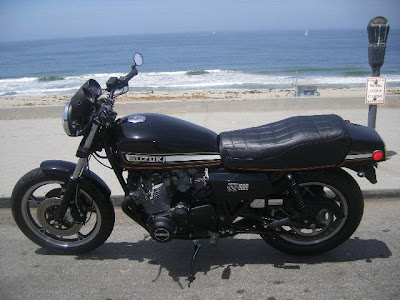
I've been riding the bike around with the aftermarket exhaust and opened stock airbox, but I always felt like it rode a little "flat". I know that 4:1 pipes do weird things to intake resonances and can cause holes in the rev range with an untuned airbox. Since each carb is connected together, a reverse wave through one can disturb the other three - this will richen or lean the mixture depending on which cylinder is next in the firing order and what rpm.
On newer bikes everything is optimized to run perfectly together and the stock airbox is sized and divided to eliminate this effect and push the torque curve up in certain areas. Starting in the mid-1980s and after, removing an airbox usually reduces horsepower and torque all over the place, with only minimal high-rpm power gains. Same thing can happen when you modify the exhaust header of one of these bikes.
Lucky for me, 1970s Suzuki engineers weren't nearly so precise. The stock GS1000 airbox is semi-restrictive, and probably only helps torque in a very narrow range of engine speeds, if at all. I've seen dyno graphs of these engines, and properly jetted there is almost always power gains above 2000 rpm when the airbox is ditched. By 6000-7000 rpm there's a huge (relative) power increase with no airbox - maybe 4 horsepower, which on a 80 horsepower motor is 5%.
So I started searching for some quality pods - the K&N ones are the best, and lucky for me a found a set for a reasonable price. The cheap knock-offs are more restrictive, and they don't have the nice radiused inlet the K&Ns have.

I could have jetted the bike myself for the pods, but the biggest change would have to be in the mid-range, which is determined by the needle. Needles are a serious pain to change out, but the stock needle would be difficult to make work with the pods. Some guys recommend restricting the air bleed passage to the main jet, but that just seems wrong to me (since it would have a greater effect at high speeds, meaning you'd need a larger main jet).
So in the end I just paid for a dynojet kit. A lot of guys on the GS Resources have this kit, and setting it up has been well documented. It's a little more expensive than swapping jets and needles yourself, but if you have to try two or three needles to get it right then you will spend as much as the DJ kit.
I dropped it in one afternoon, using the DJ 138 jets and the DJ needle with the clip in the 4th position from the top. I left the pilot fuel screws alone because the DJ kit didn't really mess with the low-speed circuits, and the stock airbox isn't much of a restriction at idle and cruise rpm.
Once running the pilot air screws required only a tiny adjustment to get it idling nice. A few quick runs down the street and plug chops showed that everything looked pretty good. My impression so far is that for such a small change this really helps the motor. The bike was fast before, but now it really flies, especially at high rpm. No more flat spots that showed up when I added the pipe, just a good strong pull from 3000 to redline. I'll have to start working my biceps to hold on better!

I don't plan to do much more to the bike. I have it running and handling amazingly. It would be nice to swap to better shocks but that would require spending more money on it, and the ones on there now are OK. My friend Dan is working on a brake conversion that uses late-model Kawasaki calipers on the stock rotors, which sounds promising. The stock brakes are pretty good but rather wooden and there isn't much feel. I may look into his brackets when they're done, but it won't be soon. For now I'm content to just enjoy the good weather and get some miles under it.
 If you've been reading the blog for a while you might remember that I bought a mate to my first GS1000 (check out the post here). After getting it home, getting it running and scrounging up all of its missing parts, I realized that I didn't have the time, energy or money for another bike project. So I passed it on to my friend Dan in Redondo Beach.
If you've been reading the blog for a while you might remember that I bought a mate to my first GS1000 (check out the post here). After getting it home, getting it running and scrounging up all of its missing parts, I realized that I didn't have the time, energy or money for another bike project. So I passed it on to my friend Dan in Redondo Beach. Dan got hard to work and built a neat mild custom out of it over the past few months. He used some really cool parts, like a Yoshimura exhaust and some mini turn signals that I gave him. The finished bike is way tougher looking than the bruiser. I like the black case covers, myself. They contrast well with the stock paintjob.
Dan got hard to work and built a neat mild custom out of it over the past few months. He used some really cool parts, like a Yoshimura exhaust and some mini turn signals that I gave him. The finished bike is way tougher looking than the bruiser. I like the black case covers, myself. They contrast well with the stock paintjob. It definitely makes me miss The Bruiser - I found myself cruising Craigslist for another one just today.
It definitely makes me miss The Bruiser - I found myself cruising Craigslist for another one just today.


